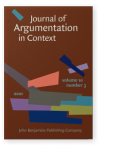Vol. 10:3 (2021) ► pp.368–396
“Completely impartial opinion, okay?”
An argumentation-theoretical approach to sponsorships on YouTube
Sponsorships on YouTube – i.e., video creators on YouTube promoting a third-party product or service to their audience – have attracted considerable research interest recently in various disciplines. This multidisciplinary study analyzes it from the perspective of argumentation theory, specifically pragma-dialectics, which offers valuable new insights into the discursive tensions inherent to this type of promotion. These tensions arise between the creator’s relationship with their audience on the one hand, which is built upon ‘parasocial’ evaluations of authenticity and community, and the commercial third party brand on the other. The insights provided by the pragma-dialectic analysis are demonstrated by means of a case study examining a sponsorship segment by YouTuber PewDiePie, which shows that creators can employ specific types of presentational choices and audience adaptation strategically to undercut commitment to the sponsor while furthering the relationship with their viewers.
Article outline
- 1.Introduction
- 2.YouTube creators, viewers and sponsorships
- 3.An argumentation-theoretical perspective
- 3.1Pragma-dialectics, strategic maneuvering and ethos
- 3.2The sponsorship as an argumentative activity type
- 4.Case study: “Completely impartial opinion, okay?”
- 4.1Method
- 4.2Analysis
- 4.2.1Presentational choices
- 4.2.2Audience adaptation
- 4.3Overview and evaluation
- 5.Discussion and conclusion
- Acknowledgements
- Notes
-
References
